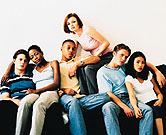
TUESDAY, Feb. 8 (HealthDay News) — Teens who are already popular but trying to become even more so are the most likely to bully other kids, new research suggests.
The kids seem to think that antagonizing others will raise their own status in the eyes of their peers, according to the study, published in the February issue of the American Sociological Review.
Researchers asked about 3,700 students in 8th, 9th and 10th grades from three counties in North Carolina about their behavior toward others and how often they were the target of physical aggression, verbal aggression (such as teasing or threats), rumors or indirect bullying (such as ostracism). Teens were also asked how often they did this to a classmate.
The study team, which followed students over one school year, also asked kids to name their top five friends, then used that data to determine which kids were the most popular and at the center of the school’s social network.
Kids who were at the top of the social pecking order, but not at the very top, were the most likely to tease or be aggressive toward others.
“Status increases aggression,” said lead study author Robert Faris, an assistant professor of sociology at University of California, Davis. “For a long time, people perceived aggression as a maladjusted reaction to problems at home or mental health issues, but our research is consistent with the idea it’s a nasty underbelly to social hierarchies. Aggression is perceived to be a way of getting ahead.”
In fact, bullying peaked at the 98th percentile of popularity and then dropped for the most popular kids — the top 2 percent — perhaps because they no longer feel the need to put others down to improve their own status.
The average aggression rate, or the number of classmates they teased or bullied, for kids at the 98th percentile was 28 percent greater than for students at the very bottom and 40 percent greater than for students at the very top.
“Aggression could be counterproductive when you’ve reached the top,” Faris said. “It could signal insecurity with their social position. If you are at the top, you may get much more benefit from being nice.”
Kids at the very lowest end of the popularity spectrum also did little bullying, possibly because they did not have the power to even attempt it, Faris said.
Perhaps the good news is that about 67 percent of kids were not aggressive or mean toward anyone. Of the 33 percent who were, they picked on an average of about two classmates.
The maximum number of kids any one bully targeted was nine, but targeted children were picked on by as many as 17 of their classmates, the researchers found.
“Aggression can be concentrated on a few kids,” Faris said.
Girls and boys were equally as likely to bully. Kids who moved higher on the social hierarchy also increased their aggression.
So what to do about it? Rather than focus only on the bullies or their victims, programs should also include the silent majority who aren’t involved, but whose tacit support may encourage bullying. “The bystanders give people their status, and they can decide to reward aggression or scorn it,” Faris said.
Richard Gallagher, director of the Parenting Institute at New York University Child Study Center, said this research fits with prior studies linking popularity and bullying.
“Other studies have indicated that popular children are the ones more likely to get involved with teasing and sometimes bullying,” Gallagher said. “It establishes their status, and many times the kids that observe it will think that it’s deserved and justified.”
Whether such abuse actually succeeds in raising status was not measured in this study. What’s notable is that students believe it works, the authors wrote. However, they noted that the findings, which were based on 19 small-town and or rural schools, may not be replicated in other areas.
Bullying causes about 160,000 U.S. students to skip school each day, according to background information in the study. Kids who are being targeted should be taught to be assertive, but also to notify their parents and school authorities if the bullying gets out of hand, experts say.
“Parents need to recognize this is going to happen. They need to teach their kids to stand up for themselves and not be so fragile when it comes to teasing,” Gallagher said. “At the same time, we need to watch out for its excesses.”
More information
The U.S. Department of Health and Human Services has more on preventing and stopping bullying.

